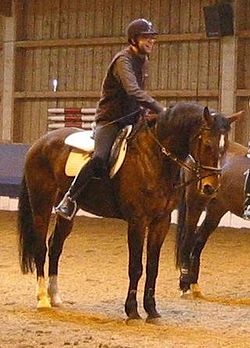Brandenburger Warmblood
| Brandenburger Warmblood | |
|---|---|

|
|
| Important data | |
| Origin: | Brandenburg |
| Main breeding area: | Brandenburg |
| Distribution: | small breeding in 2003 in German Sport Horse risen |
| Stick measure : | 162-170 cm |
| Colors : | predominantly bay, fox and black horse |
| Main application area: | Riding horse |
| Branding | |
|
|
|
|
|
|
The Brandenburg Warmblood was a horse breed that, despite its long history, only emerged in its present form in the 1960s in the former German Democratic Republic .
Background information on horse evaluation and breeding can be found under: Exterior , interior and horse breeding .
Exterior
Brandenburgers have an expressive head, a good neck and usually a well-positioned shoulder. Strong croup, kidneys and metacarpal are present. The most common opaque colors are brown, fox and black. Her height is 162–170 cm.
interior
The modern Brandenburger is a balanced but lively sport horse that is suitable for all branches of riding and driving sports.
Breeding history
Prussia until the First World War
The beginning of the targeted breeding of the Brandenburg Warmblood can be seen with the founding of the Friedrich Wilhelm Stud in Neustadt an der Dosse in 1788 by Friedrich Wilhelm II . Up until this point in time, the focus of horse breeding in Brandenburg was primarily a horse that could be used in agriculture. Friedrich Wilhelm II had his eye on the breeding of fast cavalry horses, which until then were only available as imports. Since these horses were too light and nervous for agriculture, a breeding began in Brandenburg, the framework conditions of which changed again and again. Sometimes breeding tended more towards warm blood for military purposes, sometimes it tended more towards cold blood for agricultural purposes, sometimes cold and warm blood breeding ran parallel to one another.
1920 to 1945
It was not until the 1920s that a breeding goal was gradually found with the crossing of Hanoverians , which resulted in a strong warmblood that was broadly suitable for both purposes. Thanks to strong state support for breeding, it was possible to create a largely uniform breed within about 20 years. The Second World War almost completely ruined the efforts. Much of the remaining horse population was transferred to the USSR as reparations .
GDR time
Since horse breeding turned out to be unprofitable after the war due to the onset of motorization, breeding policy was reorganized in the entire GDR in the early 1960s. The entire GDR was divided into three areas, north, middle and south with the stallion depots Redefin , Neustadt / Dosse and Moritzburg , and a uniform breeding of the noble warmblood of the GDR was sought.
Reunification until today
With the German reunification, responsibility for horse breeding fell back to the new federal states, with which this uniform breeding ended and five breeding associations were founded again. In 1990 the Brandenburger Zuchtverband was re-established.
Since then, the breed has been able to develop into a successful sport horse breed by crossing Holstein and Westphalia . In 2003 the horse breeding associations of Berlin-Brandenburg, Saxony-Anhalt, Saxony and Thuringia founded a joint breeding book for their riding horse population with the German Sport Horse.
One of the greatest successes of this breed is the mare Poetin by Sandro Hit from the poetry of Brentano II . She was bred by the Brandenburg Main and State Stud Neustadt / Dosse and was Bundeschampioness in 2000 and 2003 and World Champion of six-year-old dressage horses in 2003. At the PSI auction 2003 she was auctioned off to a stud in the Netherlands for the record sum of 2.5 million euros. In 2005 poet fell ill with laminitis and had to be put to sleep .
Individual evidence
literature
- Jasper Nissen: Encyclopedia of Horse Breeds , ISBN 3440061973